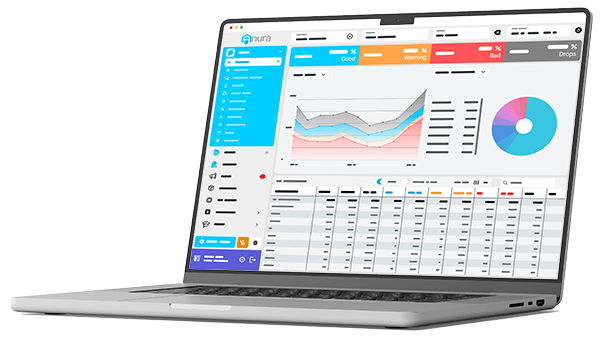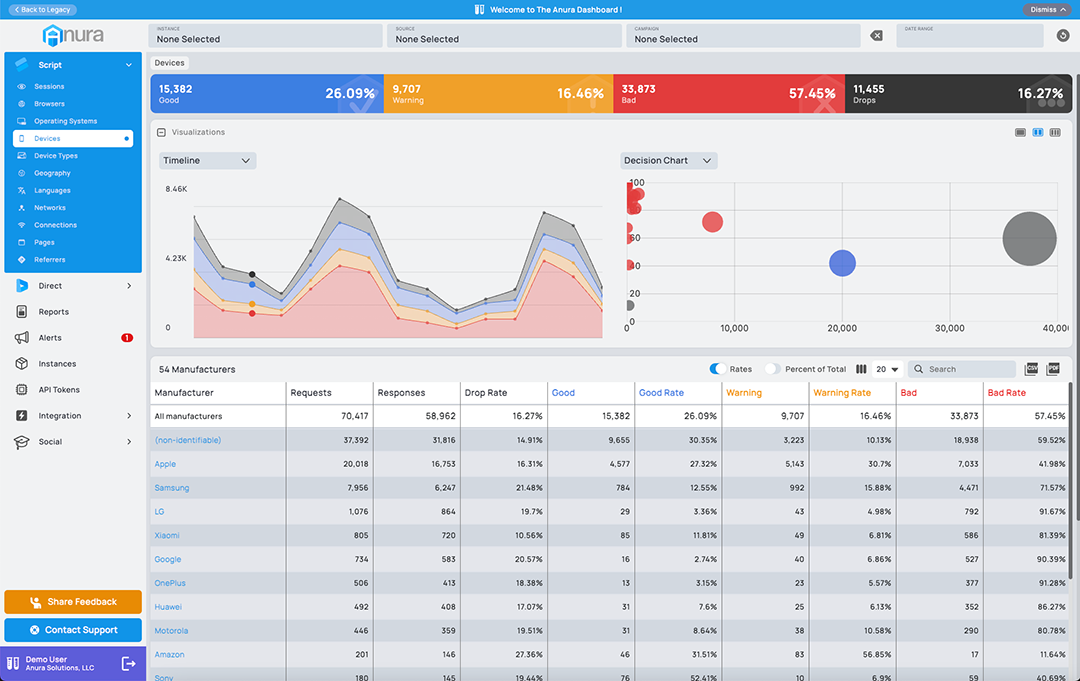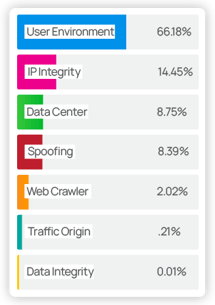6 min read
Are Some Channels More Vulnerable to Ad Fraud?
Don’t Touch That Dial! You Don’t Have to Change Channels to Get Positive Ad Results
There’s so much for marketers to...

We deliver the level of accuracy, thoroughness, and analytics to exceed the demands of every industry. Anura’s fraud solution provides you with a complete suite of features and offers unparalleled customer service.
Anura doesn’t just mitigate ad fraud, it grows your company. Since making the switch to Anura, our clients have seen a 100% improvement in the quality of traffic and increased their spend with us. Anura is boosting our ROI along with helping our company grow; no other ad fraud solution has ever done that for us.

Aided by Anura Solutions, QuinStreet was able to apply existing brand spend more productively; conversions increased 20-25% with no change in budget allocation. This led to further increases in QuinStreet’s branded wallet share.

Our number one priority is to protect the quality of leads that we send to our advertisers. To that end, an essential component of our analytics platform is Anura. Unlike other fraud detection solutions that we've tried, Anura avoids false positives and gives us the insights that we need to navigate an always challenging affiliate landscape.

Anura and their team have been instrumental in our efforts to maintain high-quality traffic to our site while growing our network audience. Their platform aligns with our mission to deliver high intent users to our carrier partners, and we've been pleased with the overall results.

Anura literally saved our business. We were getting swarmed with untold amounts of bot traffic to our call/sales funnel, but with the installation of a snippet of Anura code and some tech wizadry (all of which they walked me through)... problem solved and business saved! Biz-saving, stress reducing, and worth every penny.

I have worked with Anura for a couple of years now. They have excellent client service, and the product has met every expectation I have engendered. They have responded quickly and effectively to our requests to enhance our product experience. I recommend them without reservation.

Picture Anura and other ad fraud solutions like a Venn Diagram. There is a section that overlaps that both Anura and other solutions catch, but then there is the other area. We find that the Anura system catches a lot of stuff the others didn't, and overall, paints a better picture of what is actually happening.
Anura was able to identify the affiliates who were not the best affiliates. We were able to start pruning our affiliate lists because of what we found in Anura. We were going to pay affiliates a lot of money, but because of chargebacks and other issues, we were actually losing money.
At Gaijin Entertainment, we're running all of our relevant online traffic by Anura to eliminate user acquisition fraud for our online gaming titles. They have helped us to greatly reduce direct acquisition costs as well as the time needed to identify and ban fraudulent sources. They have a great and very responsive customer service that promptly handles questions and other inquiries. A definitive recommendation.

Beyond the easy-to-use analytics dashboard, BriteBox trusts in the accuracy of Anura's identification of fraud, both in the pre-bid and post-click analysis. After processing over 18 million visitors and yet to see a false positive, BriteBox sees the long-term benefits of having accuracy in their ad fraud vendor.

Anura doesn’t just mitigate ad fraud, it grows your company. Since making the switch to Anura, our clients have seen a 100% improvement in the quality of traffic and increased their spend with us. Anura is boosting our ROI along with helping our company grow; no other ad fraud solution has ever done that for us.

Aided by Anura Solutions, QuinStreet was able to apply existing brand spend more productively; conversions increased 20-25% with no change in budget allocation. This led to further increases in QuinStreet’s branded wallet share.

Our number one priority is to protect the quality of leads that we send to our advertisers. To that end, an essential component of our analytics platform is Anura. Unlike other fraud detection solutions that we've tried, Anura avoids false positives and gives us the insights that we need to navigate an always challenging affiliate landscape.

Anura and their team have been instrumental in our efforts to maintain high-quality traffic to our site while growing our network audience. Their platform aligns with our mission to deliver high intent users to our carrier partners, and we've been pleased with the overall results.

Anura literally saved our business. We were getting swarmed with untold amounts of bot traffic to our call/sales funnel, but with the installation of a snippet of Anura code and some tech wizadry (all of which they walked me through)... problem solved and business saved! Biz-saving, stress reducing, and worth every penny.

I have worked with Anura for a couple of years now. They have excellent client service, and the product has met every expectation I have engendered. They have responded quickly and effectively to our requests to enhance our product experience. I recommend them without reservation.

Picture Anura and other ad fraud solutions like a Venn Diagram. There is a section that overlaps that both Anura and other solutions catch, but then there is the other area. We find that the Anura system catches a lot of stuff the others didn't, and overall, paints a better picture of what is actually happening.
Anura was able to identify the affiliates who were not the best affiliates. We were able to start pruning our affiliate lists because of what we found in Anura. We were going to pay affiliates a lot of money, but because of chargebacks and other issues, we were actually losing money.
At Gaijin Entertainment, we're running all of our relevant online traffic by Anura to eliminate user acquisition fraud for our online gaming titles. They have helped us to greatly reduce direct acquisition costs as well as the time needed to identify and ban fraudulent sources. They have a great and very responsive customer service that promptly handles questions and other inquiries. A definitive recommendation.

Beyond the easy-to-use analytics dashboard, BriteBox trusts in the accuracy of Anura's identification of fraud, both in the pre-bid and post-click analysis. After processing over 18 million visitors and yet to see a false positive, BriteBox sees the long-term benefits of having accuracy in their ad fraud vendor.

Anura’s dashboard allows you to customize reporting with the ability to drill down multiple levels, pinpointing exactly where the fraud is coming from.

Ability to analyze data by unlimited source and campaign.
Definitive scoring solution – we only mark traffic as BAD when we are 100% confident it’s not a real visitor.
Choose from a variety of metrics to view your data.
Easy to visualize traffic trends over time.
Customize your data set and expose transparency to our results.
Export any report to CSV or PDF on demand.
Filter your results by specific search criteria.
View details on a variety of metrics with drilldowns and pivots to help pinpoint fraudulent traffic.
Several account management features to control your environment including a real-time reporting API, alerts, user control, and more.
Raw reports. Ability to generate and export raw transactional reports for detailed data analysis.
Make accurate and rapid business decisions based on our in depth analytics, rich with actionable information.
With our innovative and powerful solution, you can combat both SIVT and GIVT. Our Anura Script™ and Anura Direct™ installation methods work independently or together providing a cutting-edge defense against fraud!
Anura seamlessly integrates into any web asset. It is easy to install and manage, making it the perfect solution for any application.
Installation is a breeze with our Integration Wizard or step by step integration guides to get started – simply integrate your website and start collecting data!
Upon completion of integration, you will have instant access to your data. This is a powerful time saving tool that gives you quick and easy access to the information you need.
Pre-Built Integrations make it easy to get started with Anura. With Google Tag Manager and other popular platforms, you only need a few clicks of the mouse for instant fraud detection!
If we don't have the integration that fits your needs, we can develop it for you.
When a visitor has been flagged as fraudulent, you can redirect the visitor or prevent them from interacting with your page, ensuring only the highest quality of visitors.
When a visitor fills out a form, Anura validates whether it is real or fake, so you can stop wasting precious time and money on fraudulent leads.
Prevent fraudulent visitors from registering on your site and stealing valuable content like music downloads, gaming, dating, and more.
Anura can tell you a lead is fraudulent right from the ping to ensure you bid on real people that have the potential to convert.
Anura can stop fake logins before accessing your gated resources and media.
Eliminating fraudsters from filling out surveys can help to ensure that marketing data is accurate. This, in turn, can help businesses make more informed decisions about their marketing strategies.
Stop fraudsters from filling shopping carts using stolen credit cards to make fraudulent purchases.
The possibilities of using Anura are endless.
Our team of integration experts are ready to guide you, no matter which method you choose. With our experience and expertise, you can rest assured that your integration will go smoothly, so that you can focus on what's important to you.

“He who represents himself, has a fool for a client.”- Abraham Lincoln
Anura is a “TAG Certified Against Fraud” solution committed to identifying fraud and maximizing authentic customer reach before it begins to harm overall customer conversion.



Custom pricing based on usage.
For those who spend or manage $50K/month or more on marketing
Protection is our business. With the help of our specialized team, we have developed a process that ensures your company is protected from all fraud techniques.
The fraud detection process starts with our dedicated team understanding what pain points you're facing to help you identify what areas are most important.
We will provide a free trial to see how much fraud you have and show you the exact source of fraud.
Our onboarding specialists will ensure you are implementing protection correctly in all the areas that matter.
Our customer success team will then provide ongoing optimization ensuring maximum fraud protection to increase productivity and revenue growth!
Apr 10, 2024
There’s so much for marketers to...
Apr 3, 2024
It’s no secret companies lose billions of...
Mar 27, 2024
Unless you’ve been living under a rock for the past year, you know that the Federal Communications Commission (FCC) is...
Mar 20, 2024
It takes a village to fight digital marketing fraud and...
Mar 13, 2024
Have you ever watched a lottery drawing? Numbered balls bounce around until the...
Mar 6, 2024
By now, you’ve heard about the December ruling from the Federal...
